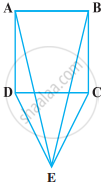Advertisements
Advertisements
प्रश्न
Angles A, B, C of a triangle ABC are equal to each other. Prove that ΔABC is equilateral.
उत्तर
Given that angles A,B,C of a triangle ABC equal to each other.
We have to prove that ΔABC is equilateral We have, ∠A = ∠B =∠C
Now,
[Opposite sides to equal angles are equal]
and ∠B = ∠C ⇒ AC = AB
From the above we get
AB= BC =AC
⇒ ΔABC is equilateral

APPEARS IN
संबंधित प्रश्न
BD and CE are bisectors of ∠B and ∠C of an isosceles ΔABC with AB = AC. Prove that BD = CE.
Which of the following statements are true (T) and which are false (F)?
Sum of any two sides of a triangle is greater than the third side.
Write the sum of the angles of an obtuse triangle.
If the angles A, B and C of ΔABC satisfy the relation B − A = C − B, then find the measure of ∠B.
If the measures of angles of a triangle are in the ratio of 3 : 4 : 5, what is the measure of the smallest angle of the triangle?
The base BC of triangle ABC is produced both ways and the measure of exterior angles formed are 94° and 126°. Then, ∠BAC =
In ∆PQR, ∠R = ∠P and QR = 4 cm and PR = 5 cm. Then the length of PQ is ______.
In triangles ABC and PQR, AB = AC, ∠C = ∠P and ∠B = ∠Q. The two triangles are ______.
CDE is an equilateral triangle formed on a side CD of a square ABCD (Figure). Show that ∆ADE ≅ ∆BCE.

Bisectors of the angles B and C of an isosceles triangle ABC with AB = AC intersect each other at O. Show that external angle adjacent to ∠ABC is equal to ∠BOC
